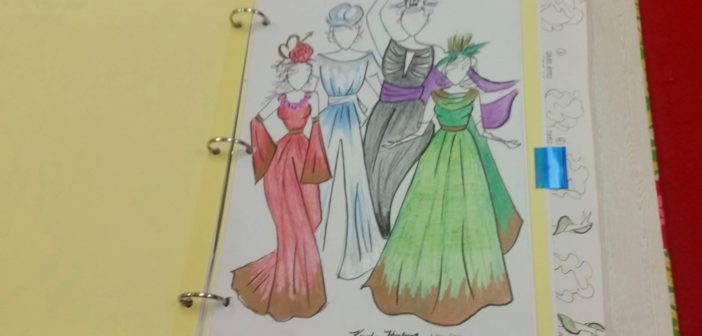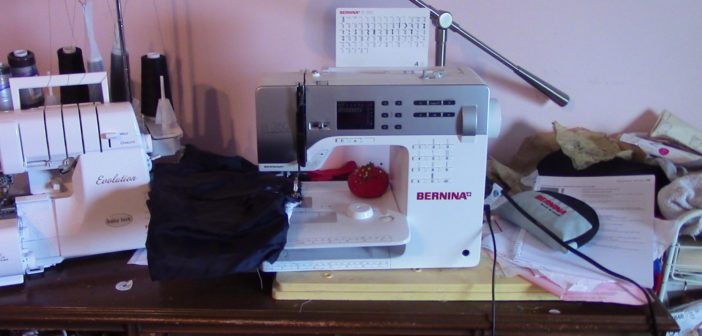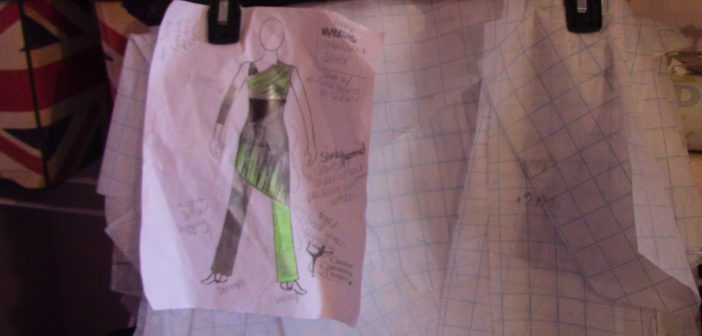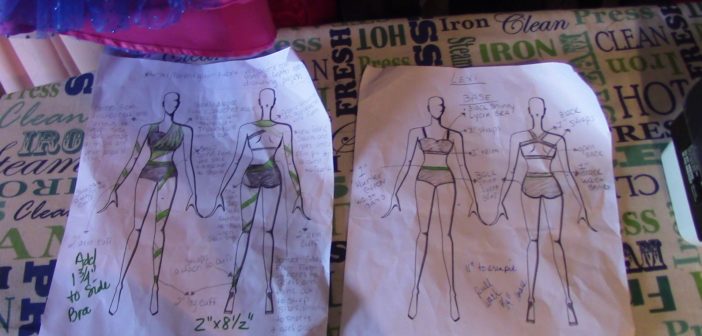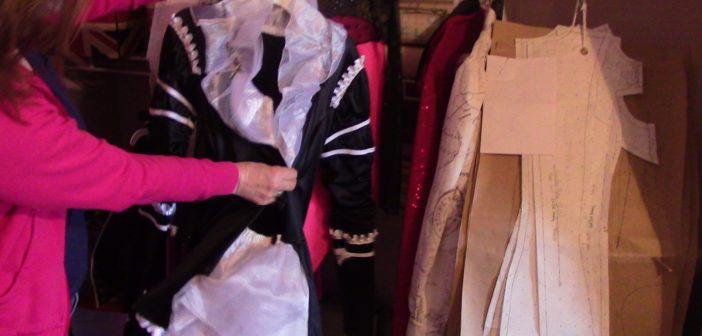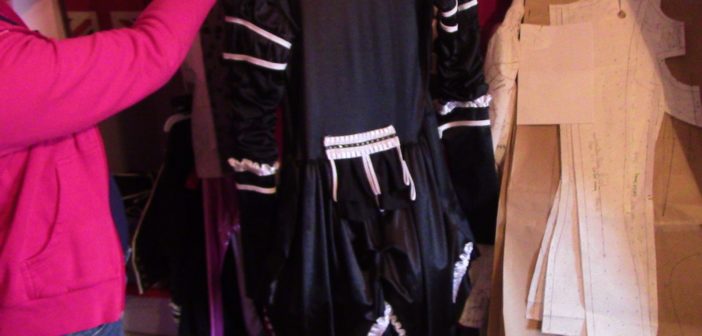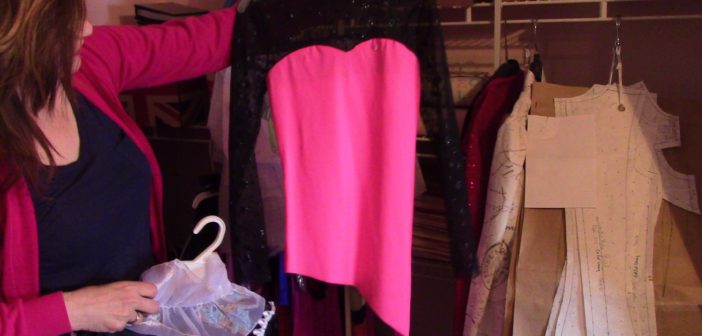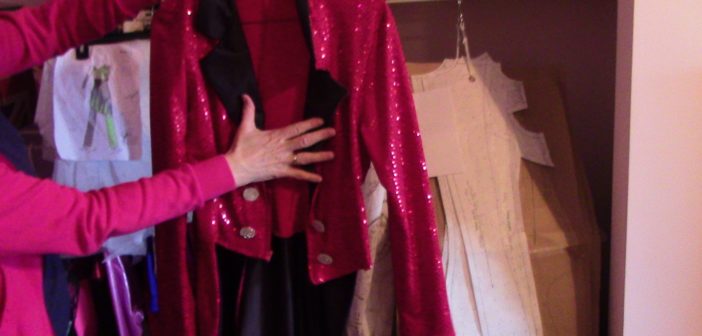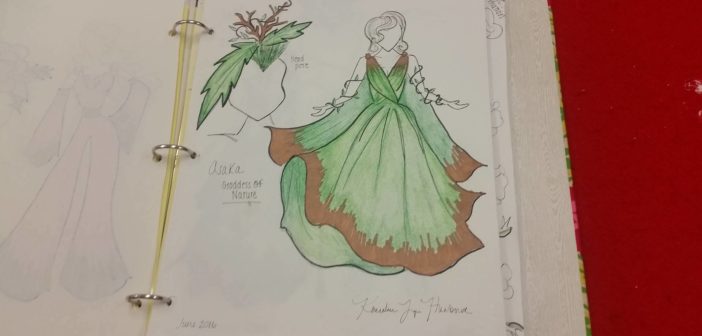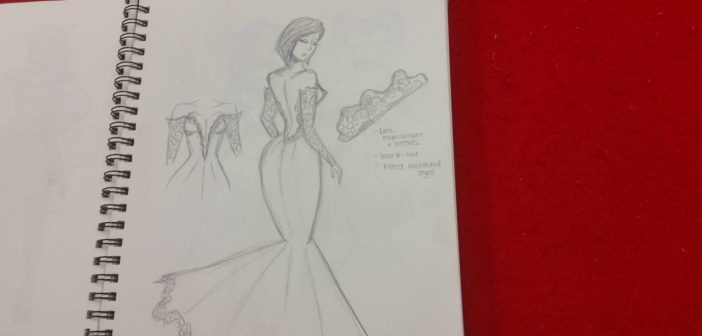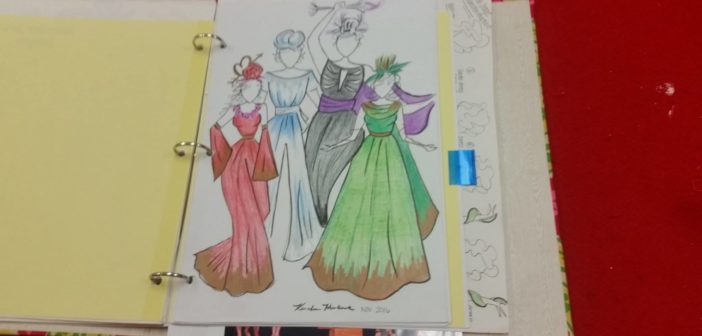This is costume designing.
Behind the scenes of a musical, play or dance production is the talented team that creates the costumes worn on stage. Eyes are drawn to the costumes, but an audience most likely never wonders how they are made. We may all just marvel at the sequins or ruffles, not taking into consideration all of the hard work and dedication that goes into the costume. Or even the fact that the costume someone sees on the performer was once a drawing on a piece of paper. From the thought process to the execution of a costume, costumers have a very detailed process.
Thought process: Inside a designer’s head
Research. Inspiration. Reading. Intense creative brain power. These are some of the key ingredients in the thought process of a costume designer.
Costume designers all have their own unique and creative way of thinking. They are inspired by vacations, moments in their lives or even by someone they may know. The inspiration goes a long way where the thought process of a costume is involved. Because after they have found their inspiration, they are ready to begin the initial process of costuming.
Surprisingly, just like a scientist, a costume designer is required to do research for costumes they are tasked with creating.
Lucy Barton of “Educational Theatre Journal” states that a costume designer’s main goal is to ensure that the costume is part of what makes the character. A good costume also helps to interpret the play and other costumes within the play. In the world of theatre and dance, and even movies, the costume designers have to read the script.
Sophomore Caitlin O’Brien, junior Alex Deane, senior Kandace Huebner and North Central professor Elizabeth Bracken, say they have to analyze the characters in the script in order to costume them correctly. Before they begin to sketch, they must understand the characters and the time period in which the play is set. Research is a very important key component in costuming in the world of theatre.
Deborah Nadoolman Landis, contributing writer for the Oscar’s official costume website, “Costume Design: Defining Character,” says research can vary from internet research to visiting archives in museums or libraries. Landis also says studying historical and contemporary visual references is helpful in the beginning of the design process.
In the world of costuming for dancers, research is not nearly as important as inspiration.
For seamstress and costume designer Kelly Klepec, her process begins with inspiration from either a person or a past vacation. Music may even spark a creative outlet for the dance costume that needs to be designed.
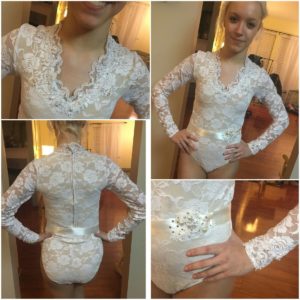
Photo by Jill Koren/Costume Director
Klepec’s main focus is the world of dance; some of her thought process and inspiration often come from the coaches or choreographers that she works alongside. Being in contact with coaches and choreographers is a big part of the thought process. They are able to bounce ideas to one another, and together, they create the costume they imagined. Just like the dance world, Bracken says working closely with directors in the theatre is very important in the beginning stages of design.
Oddly enough, O’Brien says she has to take in to account the lighting of the production too before she begins to execute her design. A lot of analyzing and research goes into creating a costume that will resonate with not just the people wearing them, but with the audience as well.
The design process: challenges and construction
Late nights. Sewing malfunctions. Communication. These are a few of the challenges and work that goes into making a costume.
The Santa Fe College fine arts department outlines the standard procedure of the construction of a costume:
- Measurements taken of all of the actors
- Materials purchased
- Patterns draped, flat patterned, and drafted
- First fitting
- Final fitting
- Distressing, trim, and other finishing work
From sketching, to fittings, to sewing, the construction of a costume is time-consuming and can also come with challenges. The construction period is when designers get to see their costumes come to life from what was just a sketch on paper. Soon enough, the costumes are ready to be worn by performers.
In order to start constructing a costume, a designer has to sketch it out. Designers will go through two rounds of sketching for a costume: preliminaries and finals, oftentimes called rendering, according to “The Secret Lives of Costumes,” of Canada’s National Arts Center.
In a setting such as North Central, sometimes costumes have to be built. O’Brien explains what building a costume entails:
Part of building a costume is playing with color, texture, pattern and how a costume is going to lay on a person, says Jill Ohanneson, Costume Designer for HBO’s “Six Feet Under.”

Photo by Kelly Klepec
Costume design usually starts by sketching, or as Klepec mentions, draping, which is utilizing a dress mannequin to envision the design by attaching fabric to the dress mannequin. However, many designers have their own process of executing their designs.
“Sometimes I do a quick sketch just to put my thoughts down. But other times I just go for it and begin draping with the fabric to see if what I’m thinking is possible in 3D form,” says Milijana Delic, a student at San Francisco School of Design. O’Brien also mentions constructing costumes vary on what designers are working on. Some costumes can take up to a couple of hours or a couple of days. Deane also notes that if a designer does not own their own sewing machine, it may become a challenge and requires hours straight of sewing the costume.
Too much communication can also become a challenge for a designer.
There are various ideas that designers must accumulate into what they think directors or choreographers want. Sometimes there is too much information and details that may muddle a costumer’s building process. According to The American Association of Community Theatre, it is important for the costume designer, director and even the set crew to look over the designs of the costumer to ensure it flows with the production. They must work together in the design process.
“Costume Design: Defining Character” says that a costume designer’s job is to bring to life a character through the designs they create.
Occasionally, challenges are not as difficult for some designers to work through. For college fashion design student at College of DuPage, Li Sheng, she says difficulties are part of the creative process. “There are difficulties in construction of the garment or choosing a wrong fabric, but I think that’s the interesting part of creation,” she says.
As for Bracken, one of her biggest challenges is being able to articulate a costume for those who have not been a part of the creative process of the costumes themselves. Designers must remember that the audience is not in the meeting with the directors. Therefore, the audience becomes a large part of the construction, so they are able to understand the characters through the costume.
“…If clothes make the man, then certainly the costume designer makes the actor! The costume designer is not only essential (but) is vital, for it is they who create the look of the character without which no performance can succeed. Theirs is a monumental job, for they must be not only artists, but technicians, researchers and historians! I am happy to honor these tireless, talented men and women who I have always been inspired by and have so much depended on!”—Audrey Hepburn, actress
Being able to design and sew can also be a major challenge a designer might encounter during their process. For Huebner, her greatest challenge is the actual sewing of the costume. Leading up to the sewing process, Huebner will sketch her design either with charcoal or watercolor. Then once the design is cleared by the director, she must begin to actually make the costume by sewing it.
At North Central, designers are also responsible for the construction part of the costume. Thankfully Huebner says she can hide her lack of sewing skills underneath the costume itself. Although she may struggle with sewing, the costumes are deemed worthy enough to appear in front of an audience.
A lot of designers have different challenges that they face during the construction stage of a costume. However, despite the struggle they encounter, they are able to create what was once a drawing into a functional and wearable costume that the audience can be enchanted by.
A designer’s passion: Why they love it
Passion. It is something a costume designer must have. They have to be able to want to create, not for themselves, but for the audience and those who wear their creations. They are artists who help bring to life a character or a dancer. A costume designer’s ultimate goal is to create a costume that will resonate with the crowd and the person wearing the costume.
“I would say don’t go into this field unless you’re really passionate about it. The indispensable quality you must have to be a costume designer is a love of human beings. You’ve got to love actors, and you’ve got to love your crew, and you’ve got to love your director. Even when you do, you’ve got to somehow create your own happiness and satisfaction through all of it. Otherwise, you will go crazy.” —James Acheson, costume designer for Spider-Man 2
After the long hours of building a costume comes to a close, designers never regret the time they have put into it. In fact, they love seeing their creations come to life. Deane’s favorite thing is seeing the actors in the costumes for the first time because it brings her creations together.

Photo by Jill Koren/Costume Director
Many designers revel in the joy of a 2D drawing becoming 3D. Delic’s favorite thing about design is seeing her sketches become an actual garment that can be worn on an actual person.
All of the hard work that is put into a costume is a reward in itself once the dancers or actors hit the stage under the lights in front of a crowd of people. Bracken loves being a designer because it allows her to be an artist and think about beautiful worlds. She also loves being forced to use various parts of her brain and the challenge that goes along with design.
Heubner says her favorite part about costume designing is sketching and then seeing it be brought to life. Although, she says it takes a while for her to appreciate her designs.
Whether it be a sequined jazz costume or a Victorian-era dress, costume designers all have one goal: to create a garment that showcases a character or a dancer. It is their duty to convey the message of the person through scraps of fabric and thread. Not only do they have to work closely alongside the choreographers or directors, but they must also know their subjects. A costume can speak a million words that maybe a script or a song cannot.
The designer turns off their sewing machine, looking at the costume that is displayed on their dress mannequin. Fabric, zippers and thread combined together to make one costume. The designer pulls stray thread from their own clothing, wiping the perspiration from their forehead and admiring their work. The costume is finally finished and ready to be worn on stage.
Editorial note: Video, writing, photos and editing by Madeline Klepec

